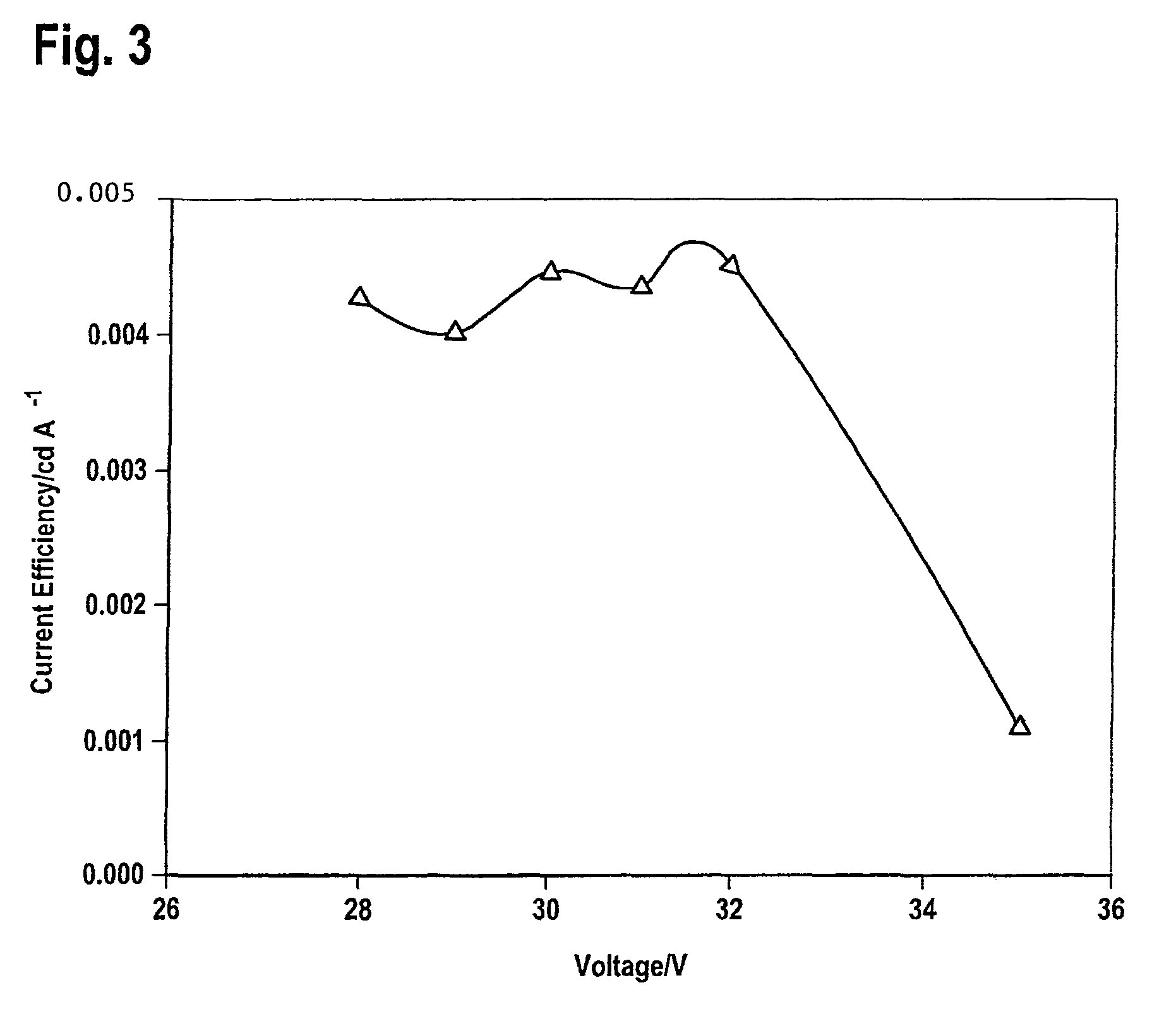Electroluminescent materials and devices
a technology of electroluminescent materials and devices, applied in the direction of discharge tube luminescnet screens, natural mineral layered products, group 3/13 element organic compounds, etc., can solve the problems of low quantum efficiency, high manufacturing cost, low efficiency, etc., and achieve the effect of high efficiency and desirable hues
- Summary
- Abstract
- Description
- Claims
- Application Information
AI Technical Summary
Benefits of technology
Problems solved by technology
Method used
Image
Examples
example 1
Synthesis of 1-phenyl-3-methyl-4-trimethylacetyl pyrazol-5-one (TMAP) from 1-phenyl-3-methylpyrazol-5-one
[0127]1-phenyl-3-methylpyrazol-5-one (25.0 g) was dissolved with warming in 235.3 ml of dioxane in 500 ml 3-neck quick-fit round bottom flask carrying a reflux condenser, a dropping funnel and stirrer. The solution was cooled to room temperature. 29.4 g of dry calcium hydroxide was added to the solution and stirred. 17.7 ml of trimethylacetyl chloride was added dropwise to the mixture in the flask with vigorous stirring within 15 mm. The mole ratio of pyrazolone and trimethylacetyl chloride is 1:1. The hot reaction mixture was stirred without heating for 40 mm and resultant orange mixture was poured into 1176 ml of chilled 3 M HCl with stirring to decompose the calcium product. The product was extracted into CH2Cl2 and the solvent was evaporated to obtain the crude product. Then the pure product was isolated as reddish-brown solution using column chromatography eluted with diethy...
example 2
Synthesis of 4-tert-Butyl-3-methyl-1-phenylpyrazol-5-one
[0129]3-Methyl-1-phenylpyrazol-5-one (5 g; 0.029 mole) was placed in a flask equipped with a stirrer and reflux condenser. Dry and distilled dioxane (40 ml) was added by warming and to the clear solution calcium hydroxide (6.4 g; 0.086 mole) was added followed by drop wise addition of tert-butylacetyl chloride (4.8 ml; 0.034 mole). The mixture was heated to reflux for 4 hours and then poured into 2M HCl (200 ml) to decompose the calcium complex. A light brown precipitate formed immediately, which was filtered off under suction after refrigerating overnight. The product washed with water and dried under vacuum at 50° C. The product was recrystallised from methanol to give an off-white crystalline solid, m.p 85-86° C.; 6.8 g (82%).
[0130]
Elemental AnalysisElementCHN% Theory70.567.4010.285 Found70.547.4310.26
example 3
Synthesis of Aluminum(1-phenyl-3-methyl-4-trimethylacetyl pyrazol-5-one)3 Complex Al(TMAP)3
[0131]A solution of 1-phenyl-3-methyl-4-trimethylacetyl pyrazol-5-one (TMAP) (3.9 mM) in ethanol (15 ml) was stirred and neutralised with sodium hydroxide (NaOH) (3.9 mM in 2 ml H20) solution. To the mixture was added AlCl3.6H2O (1.3 mM in 2 ml H20) dropwise at room temperature. Then the mixture was stirred for 5 minutes at room temperature and then warmed for another 5 minutes. The crude product, which simultaneously precipitated from the solution, was collected by filtration and washed with water and ethanol. It was dried at 65° C. for 5 hours. mp 298° C. Elemental analysis of Al complex.
[0132]Found: C, 66.64%; H, 6.37%; N, 10.22%. Cal. for Al (C45H54N606) complex: C, 67.66%; H, 6.39%; N, 10.52%.
[0133]
[0134]The product is a light-pink colour and showed blue fluorescence.
PUM
| Property | Measurement | Unit |
|---|---|---|
| thickness | aaaaa | aaaaa |
| thickness | aaaaa | aaaaa |
| thickness | aaaaa | aaaaa |
Abstract
Description
Claims
Application Information
 Login to View More
Login to View More - R&D
- Intellectual Property
- Life Sciences
- Materials
- Tech Scout
- Unparalleled Data Quality
- Higher Quality Content
- 60% Fewer Hallucinations
Browse by: Latest US Patents, China's latest patents, Technical Efficacy Thesaurus, Application Domain, Technology Topic, Popular Technical Reports.
© 2025 PatSnap. All rights reserved.Legal|Privacy policy|Modern Slavery Act Transparency Statement|Sitemap|About US| Contact US: help@patsnap.com



